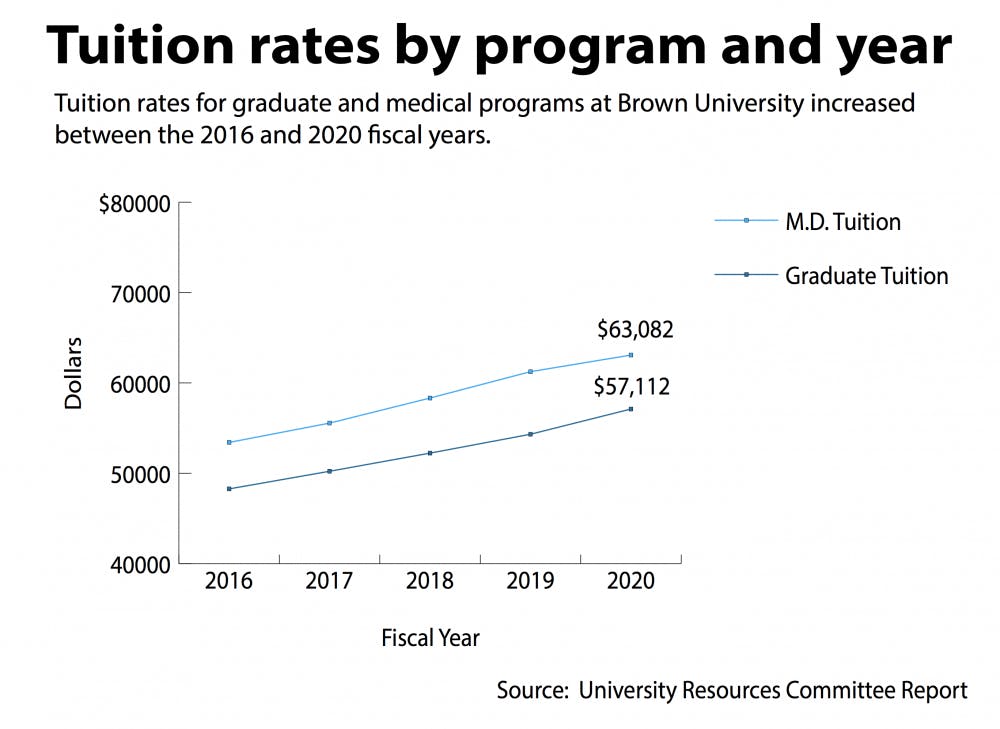Tuition for the University’s Graduate and Medical Schools will increase by 5.1 percent and 3 percent respectively next year following approval by the Corporation, the University’s highest governing body, earlier last month.
The Graduate School’s tuition will rise to $57,112, mirroring Undergraduate tuition, while the Medical School is set to charge $63,082.
The graduate school tuition increase will help the University fund larger stipends for graduate students, bolster support for graduate students who are parents and support a transitional stipend for all incoming PhD and master of fine arts students, among other initiatives, said Provost Richard Locke P’18. The transitional stipend helps students make initial purchases and payments prior to their first year.
“These were concerns that (graduate students) brought to the table and we thought it was important to fund,” Locke said.
Neither PhD nor MFA students pay tuition, so within the graduate school any increases in tuition affect master’s students, said Associate Dean for Master’s Education and Interim Associate Dean for International Graduate Students Shayna Kessel.“The University is concerned about the cost of master’s education; we are concerned about access to master’s education and the debt that students take on,” Kessel added.
Graduate Student Council President Alastair Tulloch GS said “most master’s programs don’t provide adequate or enough financial aid, especially for people who are coming from underprivileged families where they wouldn’t be able to support their education without taking out significant loans.” Although undergraduate tuition is increasing at the same rate as graduate tuition, master’s students will likely be affected “more so than undergraduate populations,” Tulloch said, “because there is no equivalent to the undergraduate Brown Promise,” which guarantees loan-free financial aid to undergraduate students with demonstrated financial need.
While “unfortunately, the Graduate School does not have the resources to offset master’s tuition,” individual departments sometimes “offer small tuition scholarships” and “are really happy to support a master’s student in whatever way they can,” Kessel said.
Locke said the University does not expect the tuition increase to affect “our graduate school populations. People are going to see that linked to the increase in tuition and fees has been a significant increase in benefits.”
For medical students, financial stress is “the hidden cost of medical school,” said President of Medical School Senate Peter Mattson MD ’20. Costs can pose particular burdens to students from “underserved backgrounds” along with those considering entering lower-paying fields of medicine, he added.
“One of the things (the MSS has) been looking into is helping people with financial aid more (by) trying to improve the financial resources for students like connecting them to certified financial advisors that the Office of Financial Aid cannot provide,” Mattson said. Though the University “compared to most other places, is more generous” when it comes to providing financial aid, initiatives like free medical school tuition at New York University are “attracting applicants in higher numbers,” Mattson added.
The tuition increase came after the University Resource Committee deliberated and voted in favor of the uptick, Locke said. The URC’s members include undergraduate, graduate and medical students in addition to faculty, staff and administrators. Locke emphasized that student members of the committee are “there as full members” and “have the same power, influence and voting status on that committee that I do.”
Tulloch works to “keep in touch” with the two graduate student representatives on the URC “to make sure the GSC is aware of what is being discussed at the meetings.” In addition, “we regularly meet with the deans of the graduate school, with the Provost, with the President, and we regularly bring up” topics such as tuition and stipend increases, Tulloch said.
Kessel noted that graduate students are “really essential partners in this process.”
In addition, Mattson and Tulloch expressed a desire for increased transparency in tuition deliberations. “This is something we’re talking about as a Senate, and we’re very aware that students want more transparency,” Mattson said.
Tulloch noted that “transparency about process and consideration of how (tuition increases) will affect master’s students is something that the GSC is concerned about.”
Looking ahead, a Brown Promise equivalent for m aster’s students “would be a worthwhile investment on the University’s part,” Tulloch said. Mattson said, “we can always do better with financial aid,” evidenced by the fact that “a lot of students, including myself, are going to leave medical school thousands and thousands and thousands of dollars in debt.”
Tulloch added that the GSC is prioritizing “making sure that the University is supporting any student who would be interested in (graduate) programs, and providing the support for those programs so that financial aid can be provided.”





